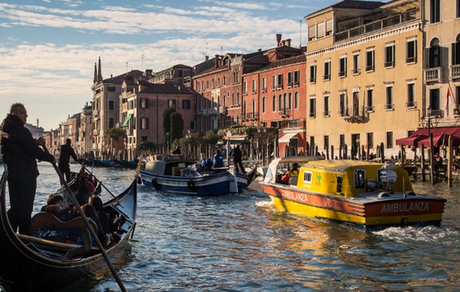Venice's Sink or Swim Moment
إقرأ هذا الخبر بالعربية
"Attenzione, the wine!"
That is an old punchline in the Weir home, thanks to plastic cups of Chianti, a low bridge and a gondolier named Marco.
His concerned bark broke the spell as my wife and I smooched and gaped, moon-eyed dorks on our first night in Venice.
When I told my dad I was taking my wife to Italy for our first anniversary, he snorted. "Where you gonna take her for your 10th? The moon?"
He was right. It was perfect. Pigeons in San Marco, sunset over the Grand Canal, Bellinis and cheeseburgers at Harry's.
Venice entered our bloodstream that trip. But in the years since, I've heard very different stories from disappointed folks back from their first trip to La Serenissima because the city of water and love now has too much of both. Too much water, and way too many lovers.
Because this impossible city of palazzos and cathedrals is built atop wooden posts driven into the muddy floor of a lagoon, Venice has been slowly sinking since Casanova canoodled down its canals.
When aquifers were tapped to build massive petrochemical plants on the nearby mainland, Venice sank faster. And then folks noticed that the sea level was on a slow but steady rise.
In the 1920s, there were about 400 incidents of acqua alta, or high water, when the right mix of tides and winds drives the liquid streets up into homes and shops in the lowers parts of the city.
By the 1990s, there were 2,400 incidents -- and new records are set every year.
But, the Italians have a plan.
It is called the MOSE Project. MOSE is an acronym for "Experimental Electromechanical Module," but it is also the Italian word for Moses, a guy known for parting the sea and protecting the faithful.
It's a system of 78 massive gates mounted to hinges on the ocean floor. The gates are filled with air, and designed to rise and create a temporary sea wall. Since the plan was hatched, low-lying cities from Miami to Mumbai have taken a keen interest to see if the idea can work.
Everybody is still waiting: MOSE is now 10 years behind schedule, and $5 billion over budget. And on one early morning in 2014, police rounded up 35 people at the highest levels of MOSE, including Giorgio Orsoni, the mayor of Venice. While several went to prison on plea bargains, the now-former mayor is fighting charges of corruption and kickbacks.
But while I went back to Venice to do a story on rising water, instead I found a surprising drama about the rising tide of humanity.
People know Venice is special and fragile, so they come -- to the tune of 20 million tourists a year.
Meanwhile, the watery headaches and cost of living has created a mass exodus of native Venetians: 100,000 have moved to the mainland in a single generation, and around 60,000 remain.
On a busy summer day, in the most popular section of the city, tourists can outnumber Venetians 600-1.
In Manhattan, that number is 8-1.
When a cruise ship dumps thousands of people into Venice at once, they squeeze down jammed medieval streets where purveyors of overpriced pizza and cheap masks have replaced the shops of artists and artisans.
Each year, more people come. Each year, less get to enjoy the city we found on that first magical night.
People have been worrying about the impending death of Venice for centuries, but the place is in trouble, now more than ever.
And in an age of rising seas and exploding populations, Venice is a test. A test to preserve beauty, history and harmony from the greatest threats: time, tide and greed.
SOURCE: edition.cnn.com - http://edition.cnn.com/2015/03/30/travel/the-wonder-list-venice-bill-weir/index.html
Follow us on #climatechangelb to engage with us.
Check the Lebanon Climate Change website: www.moe.gov.lb/climatechange
This segment is brought to you through a partnership between the UNDP Climate Change Team at the Ministry of Environment in Lebanon and the NAHARNET team. The views and opinions expressed in this article are those of the authors and do not necessarily reflect the official policy or position of any party/institution.



